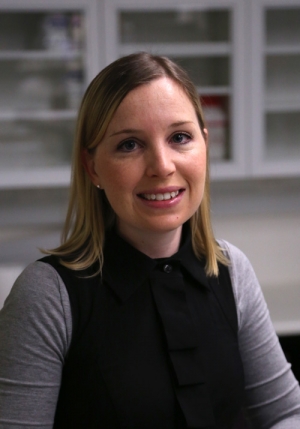Doorways to research
Research news
For Deakin University lecturer and researcher Dr Holly Chinnery, the eyes are considerably more than windows to the soul.
They are the doorways to a whole new world of cutting-edge research into the immunology of eyes - projects about which she has a driving passion first ignited by another lecturer, researcher and mentor, Professor Paul McMenamin.
“Even though we’re at separate universities now, I continue to collaborate with Paul whom I first worked with at the University of Western Australia,” said Dr Chinnery, who is a Lecturer in Vision Science in the new Optometry program within the School of Medicine.
“Paul was just so passionate and fascinating and at his suggestion I did an undergraduate research project on pig eyes.
“We did this short project and we went on a bit of a Sherlock Holmes investigation trying to figure out what was the cause of this funny little red mark across pig eyes from abattoirs.
“That was because other people in the lab were interested in understanding the immunology of the pig cornea in terms of future research for xenotransplantation.
“This is where you take a piece of tissue from an animal and put it into a human.
“Similar to transplanting pig heart valves into humans, researchers are looking to see if they can do it with corneas.
“About a third of the corneas from the pigs had to be discarded as they had this strange mark across them
“So we went to the abattoir and we watched what they did and we figured out that the carcasses were dunked into a big vat of steam to be able to remove the hairs of the skin. In about a third of the pigs, we noticed their eyes didn’t close properly.
“And that little bit of cornea that was exposed to the steam was being burnt off.
“That meant that when we got the corneas in the lab we couldn’t investigate them.
“So that was a tiny little project and instead of just finishing our studies Paul encouraged us to write that up and we did that as a really small paper.
“And that really got me excited about doing research and putting value to everything you do in the lab, not just doing experiments for the sake of it, but writing it up and getting it published.”
Dr Chinnery, whose research at Deakin will focus on corneal immunology, in particular the role that resident white blood cells play in the development of corneal inflammatory responses, has had many publications since that incipient one.
She was the first researcher to describe the in vivo existence of novel forms of cellular communication, known as membrane nanotubes, in the inflamed cornea of a mouse.
This now well cited paper was published in the Journal of Immunology, Cutting Edge.
Her research findings have also published in a range of well-respected peer-reviewed journals including Investigative Ophthalmology and Visual Science, Immunology, Journal of Neuropathology and Experimental Neurology and Neurobiology of Aging.
Deakin, with its new medical school and Optometry program, offers the opportunity for more cutting edge research – and Cutting Edge publications.
“I am really pleased to be here,” she said. “The people that I work with are really welcoming and encouraging.
“And in my role as a lecturer, I get the chance to hopefully inspire and motivate students the way Paul did me, while also continuing with my own research.”
A lot of Deakin undergraduates in the University’s thriving new Medical School can look forward to a fair bit of soul-searching of their own, it seems.
Share this story
 Dr Holly Chinnery's research at Deakin will focus on corneal immunology, in particular the role that resident white blood cells play in the development of corneal inflammatory responses.
Dr Holly Chinnery's research at Deakin will focus on corneal immunology, in particular the role that resident white blood cells play in the development of corneal inflammatory responses.
